LifeWithMyDogs is supported by our audience. When you purchase through one of our links, we may earn a small affiliate commission. As an Amazon Associate I earn from qualifying purchases. Your cost is not affected.
**********
Separation Anxiety In Dogs is a common issue that many pet owners face, often leading to destructive behaviors and stress for both the dog and their family. These signs can be overwhelming and hard to manage, from constant barking to chewing on furniture. Understanding the root causes of this anxiety and finding effective solutions is essential for ensuring a calm, happy home for your dog. Whether through behavior training, creating a comforting environment, or utilizing expert tips, addressing separation anxiety can make all the difference for your furry friend’s well-being. Let’s explore how you can help your dog feel more secure when alone.
Separation Anxiety in Dogs: Causes and Solutions – Helping Your Furry Friend Feel at Ease
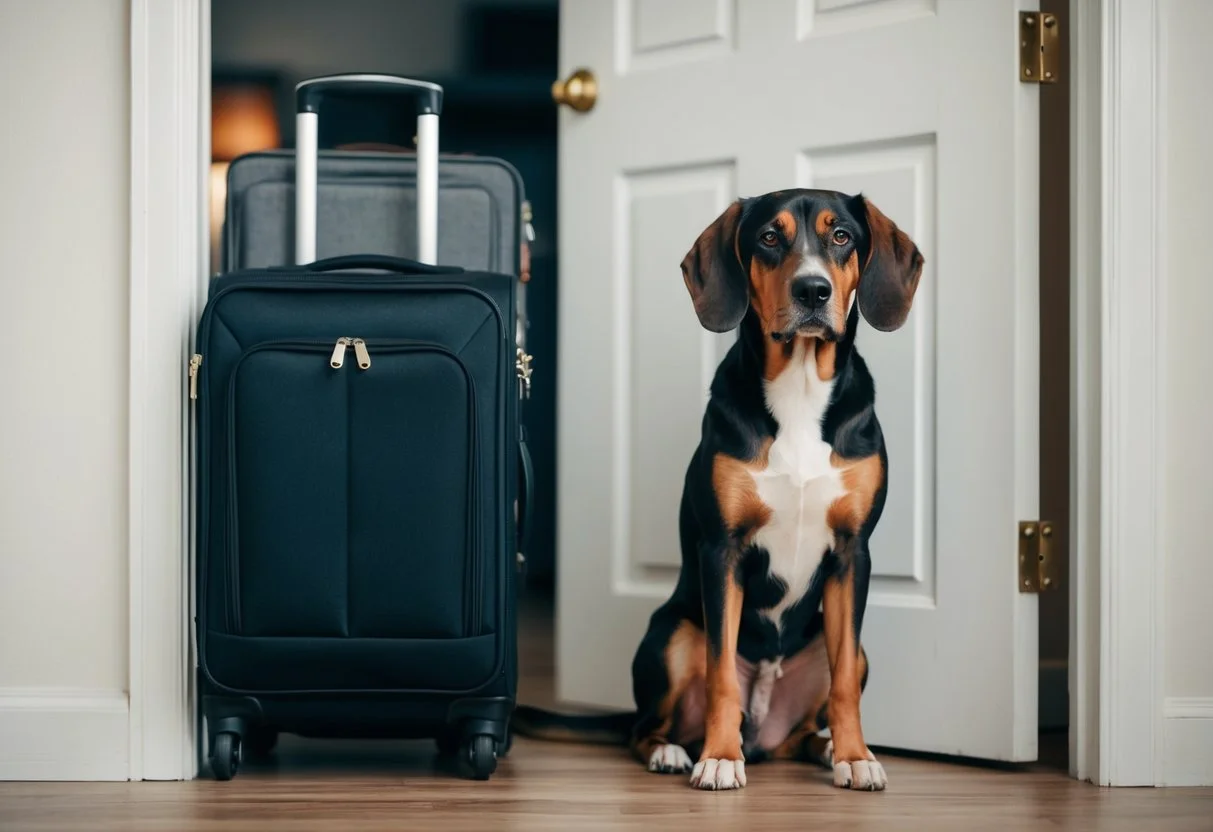
Does your dog become stressed and even frantic when left alone? Separation anxiety in dogs causes problems for many families. But take heart- it can be overcome! Dogs are our loyal friends, but they can get upset when we leave them alone. Separation anxiety in dogs is a big problem that can make both you and your pet unhappy. It can lead to barking, chewing, and other bad behaviors. You can help your dog feel better by understanding why they get anxious and learning how to fix it.
There are many reasons why dogs get separation anxiety. It could be because of changes in their home, not enough training, or even health issues. The good news is that you can help your dog feel better. You can teach your dog to be calm when you’re not home with some work and patience. This might mean changing how you act around your dog, using special toys, or getting help from a dog trainer.
Key Takeaways
- Dogs with separation anxiety show stress when left alone.
- You can help by finding out why your dog is anxious.
- Training and changing your dog’s routine can make a big difference.
Understanding Separation Anxiety in Dogs
Dogs can feel very upset when left alone. This can cause them to act in ways that are hard for owners to handle. Learning about this problem can help you and your dog feel better.
Defining Separation Anxiety
Separation anxiety in dogs is when they get very stressed when away from their owners. It’s more than just being sad. Dogs with this issue feel real fear and panic. This can happen to any dog, no matter their age or breed. Some dogs might get anxious as soon as you start to leave.
Others may only show signs after you’re gone. Separation anxiety is different from boredom. A bored dog might make a mess, but an anxious dog will seem truly upset.
Common Signs and Symptoms
Dogs with separation anxiety often show clear signs. You might notice your dog pacing, whining, or shaking as you get ready to leave. When you’re gone, they might:
- Bark or howl a lot.
- Chew things up or dig at doors.
- Have accidents in the house.
- Try to escape.
Some dogs might also refuse to eat when left alone. Others might follow you around closely when you’re home. These behaviors usually start soon after you leave and continue until you return.
Behavioral vs. Medical Issues
Knowing if your dog’s problem is behavioral or medical is important. Some health issues can look like separation anxiety. Things to check:
- Bladder problems.
- Side effects from medicine.
- Age-related issues in older dogs.
If you’re unsure, it’s best to talk to your vet. They can help figure out if there’s a medical reason for your dog’s behavior. Separation anxiety is a psychological condition. It’s not your dog’s fault; they’re not trying to be bad. With the right help, many dogs can learn to feel better when alone.
Causes of Separation Anxiety
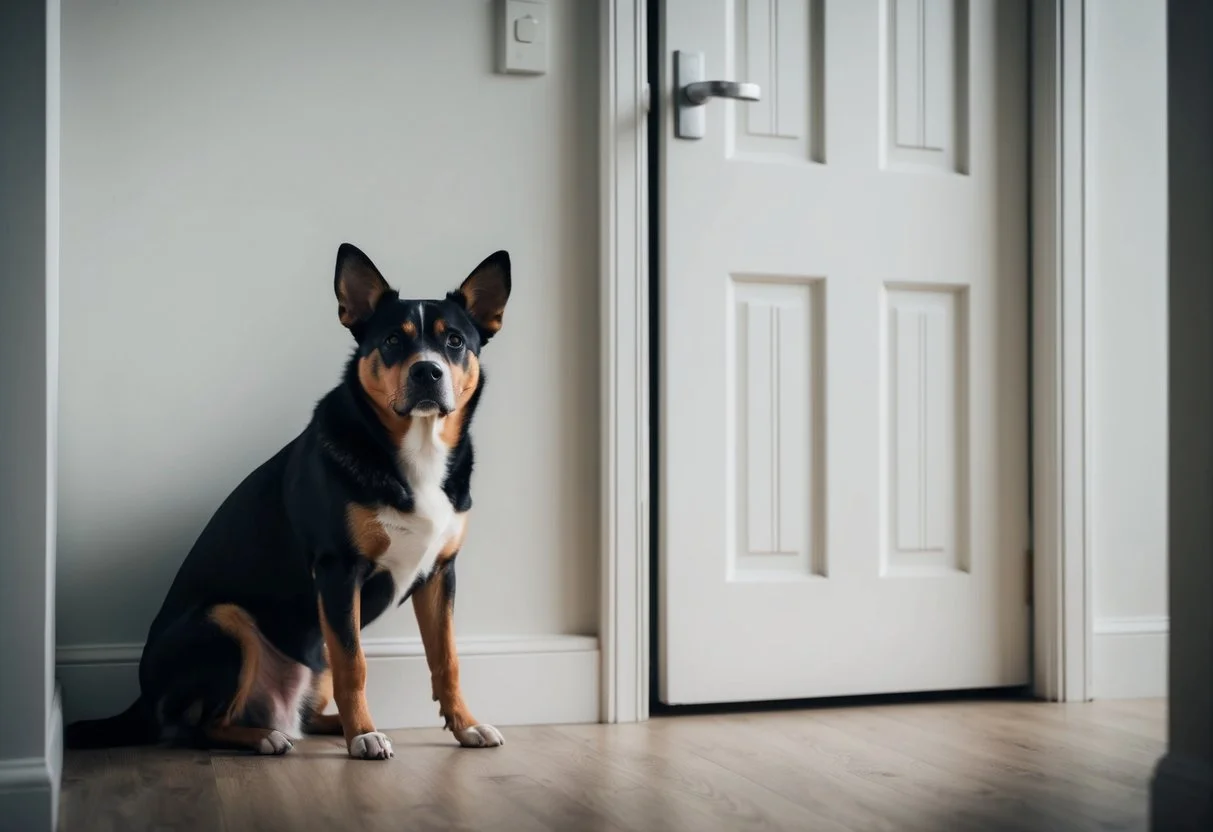
Dogs can develop separation anxiety for various reasons. Certain factors may make some dogs more prone to this condition than others. Let’s explore the main causes of separation anxiety in dogs.
Genetic Predisposition
Some dogs are more likely to develop separation anxiety due to their genes. Certain breeds, like Labrador Retrievers and German Shepherds, may be more prone to this condition. Your dog’s personality also plays a role.
Anxious or clingy dogs might be more susceptible to separation anxiety. Puppies who are taken from their mothers too early can develop attachment issues. This early separation can lead to anxiety later in life.
Environmental Factors
Your dog’s living situation can contribute to separation anxiety. If you work long hours or travel frequently, your pet may struggle with being alone. Moving to a new home can be stressful for dogs. The unfamiliar environment might make them feel insecure when left alone. Lack of proper socialization during puppyhood can also lead to anxiety. Dogs who aren’t exposed to different people, places, and situations may become overly dependent on their owners.
Changes in Routine or Family Structure
Dogs thrive on routine. Any significant changes can trigger separation anxiety. A new work schedule that leaves your dog alone for longer periods can cause stress. Similarly, changing your family structure, like a new baby or a family member moving out, can upset your dog’s sense of normalcy. Even positive changes, like adopting a new pet, can sometimes lead to anxiety in your existing dog.
Traumatic Events and Phobias
Past traumatic experiences can make your dog fearful of being alone. If your pet has been through a natural disaster or spent time in a shelter, they might develop separation anxiety. Loud noises like thunderstorms or fireworks can create lasting fears.
These phobias may cause your dog to associate being alone with these scary events. A bad experience while you were away, such as a break-in or an injury, can also trigger anxiety about future separations.
Assessing Your Dog’s Anxiety Levels
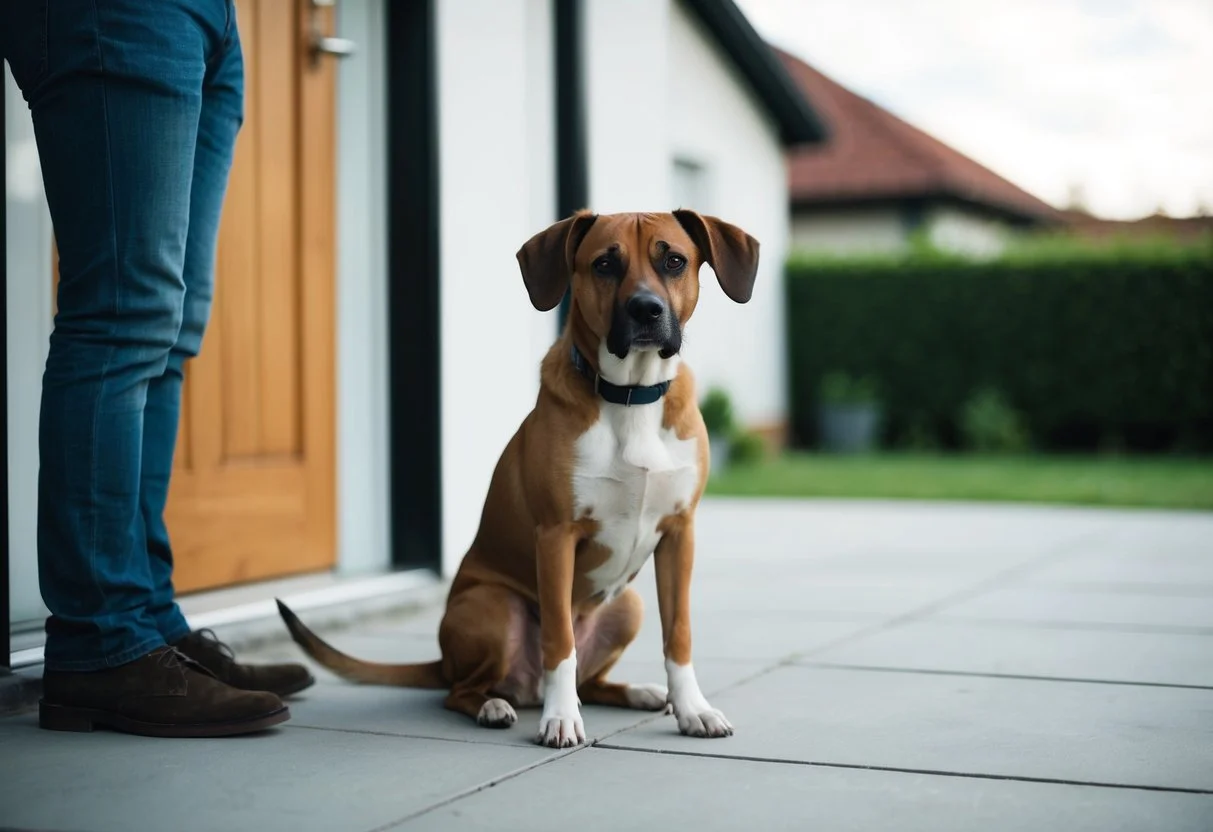
Spotting signs of separation anxiety in dogs can help you take the right steps to address the issue. Using simple observation techniques at home and seeking expert help, you can better understand your pet’s behavior and find effective solutions.
Observational Techniques
To assess your dog’s anxiety, pay close attention to their actions when you’re about to leave or when you’re gone. Look for anxious behaviors like:
- Pacing.
- Whining.
- Trembling.
- Excessive barking or howling.
- Destructive acts.
Try setting up a camera to watch your dog when you’re out. This can give you a clear picture of how they act when alone. Keep a log of your dog’s behavior. Note down when symptoms occur and how long they last. This info can be super helpful for you and your vet when spotting patterns.
Consulting with a Professional
A vet or a dog behaviorist can give you expert insight into your dog’s anxiety. They can rule out other health issues that might look like separation anxiety. Professionals use special tools to assess your dog’s behavior. They might ask you to complete detailed questionnaires about your pet’s habits.
Your vet might suggest tests to check for physical causes of stress. They can also help you create a plan to manage your dog’s anxiety. Don’t hesitate to seek help if you’re worried. Early intervention can make a big difference in your dog’s well-being.
Did you Know?
Dealing with a dog’s separation anxiety can be tough. Don’t worry – many helpful resources are available to support you and your furry friend through this challenge. You can find comfort and advice in online groups for dog owners. Facebook groups focused on separation anxiety are great places to connect. Reddit’s r/dogtraining community offers tips from experienced owners.
General Solutions and Management Strategies
Dealing with separation anxiety in dogs takes time and patience. You can help your furry friend feel more secure when left alone through environmental changes, training, and activities.
Creating a Safe Space
Give your dog a comfortable area to relax in when you’re away. This could be a crate, a specific room, or a cozy corner. Make it inviting with the following:
- Soft bedding.
- Favorite toys.
- A piece of clothing with your scent.
Play calming music or leave the TV on for background noise. Some dogs find white noise machines soothing. Use essential oils like lavender to create a peaceful atmosphere. Puzzle toys filled with treats can keep your dog busy and happy. Try freezing a Kong toy with peanut butter inside for a long-lasting distraction.
Training Techniques to Build Independence
Start with short periods of separation and gradually increase the time. Practice these steps:
- Tell your dog to “stay” and walk to another room
- Return quickly and reward calm behavior
- Slowly extend the time you’re out of sight.
Avoid making a big fuss when leaving or returning home. This helps your dog see your comings and goings as normal events. Teach your dog a “settle” command. Use it when you need them to relax on their bed. Reward them for calm behavior. Try desensitization techniques like picking up your keys or putting on your coat without leaving. This helps reduce anxiety around departure cues.
Exercise and Mental Stimulation
A tired dog is more likely to rest when alone. Before leaving:
- Take your dog for a brisk walk or run.
- Play fetch or tug-of-war.
- Set up an agility course in your yard.
Mental exercise is just as important as physical activity. Try these brain games:
- Hide treats around the house for your dog to find.
- Teach new tricks or practice old ones.
- Use interactive toys that dispense treats.
Consider doggy daycare or a dog walker for days when you’ll be gone for long periods. This breaks up your dog’s alone time and provides social interaction. Regular exercise and mental challenges help reduce anxiety and promote overall well-being in dogs.
Behavioral Modifications and Training
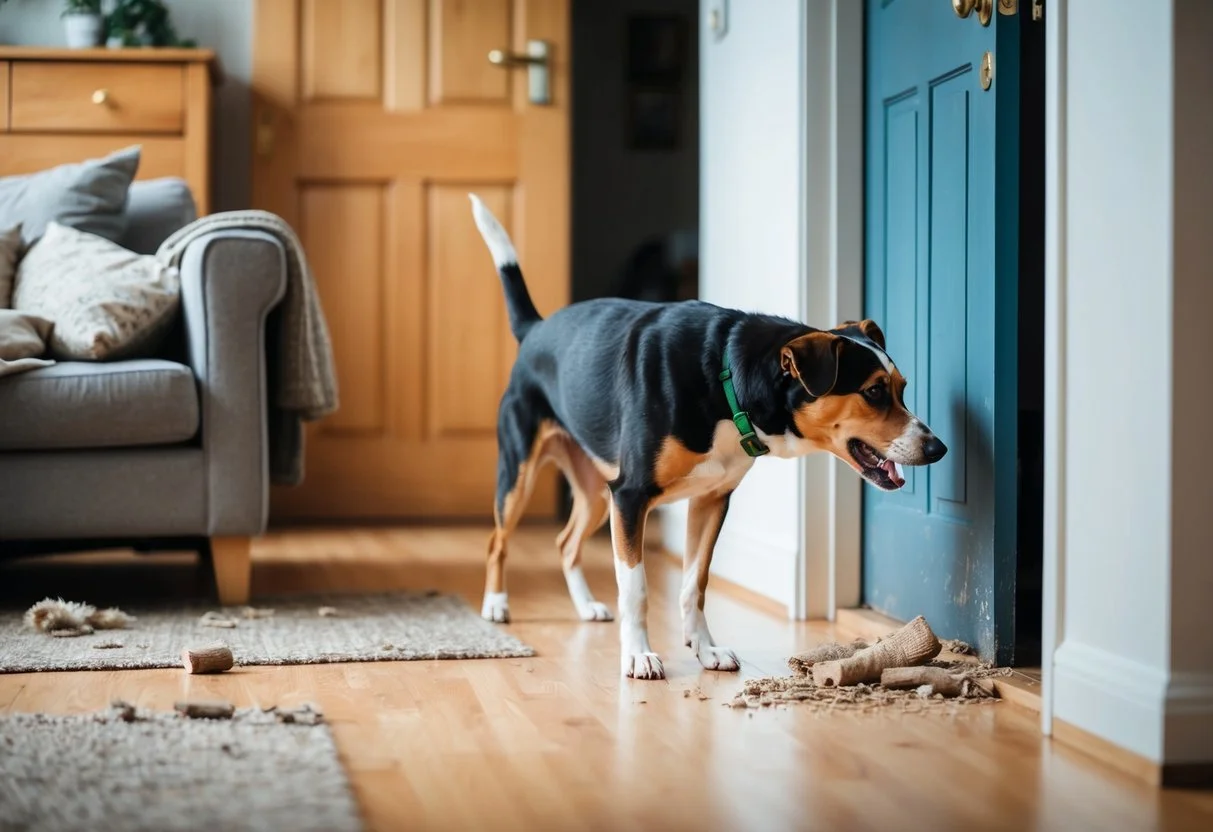
Training can help with separation anxiety in dogs by making them feel more comfortable when left alone. The right approach can reduce anxiety and build confidence. Here are some key methods to try:
Counter-Conditioning
Counter-conditioning changes how your dog feels about being alone. Start by giving your dog a special treat only when you leave. Use something tasty like cheese or chicken. This helps your dog link your departure with good things.
Next, practice short departures. Leave for just a few seconds at first. Slowly increase the time you’re gone. Don’t make a big fuss when you leave or return. You can also use toys to keep your dog busy. Try a puzzle toy filled with treats. This gives your dog something fun to focus on instead of worrying.
Desensitization Methods
Desensitization helps your dog slowly get used to being alone. Start with very short absences. Leave the room for just a moment. Come back before your dog gets upset. Gradually increase the time you’re away. Watch for signs of stress, like pacing or whining.
If you see these, go back to shorter times. You can also desensitize your dog to departure cues. Pick up your keys or put on your coat, but don’t leave. This teaches your dog these actions don’t always mean you’re going.
Positive Reinforcement
Reward calm behavior when you’re home. If your dog is relaxing quietly, give praise or a treat. This teaches them that being calm is good. Create a safe space for your dog. Use a crate or a specific room. Make it cozy with beds and toys.
Give treats there so your dog likes the space. Practice “stay” commands. Start with short distances and times. Reward your dog for staying put. Slowly increase the challenge. This builds your dog’s ability to be alone.
Professional Interventions and Therapies
Seeking expert help can make a big difference for dogs with separation anxiety. Several effective options exist, from working with specialists to trying medications or alternative approaches for managing separation anxiety in dogs.
Working with a Dog Behaviorist
A dog behaviorist can create a custom plan for your pup. They’ll watch how your dog acts and give you tips to help. Here’s what they might do:
• Check your dog’s routine and suggest changes.
• Teach you how to use desensitization techniques.
• Show you how to reward calm behavior.
• Help set up a safe space for your dog when alone.
Behaviorists can spot things you might miss. They know what works for different dogs. With their help, you can learn the best ways to ease your dog’s worry.
Anxiety Medications
Sometimes, dogs need medicine to feel better. Your vet might suggest:
• Antidepressants like clomipramine or fluoxetine.
• Anti-anxiety meds for quick relief.
• Natural calming supplements.
These can help your dog relax and learn new habits. But they work best with training, too. Always talk to your vet before giving any meds. They’ll make sure it’s safe and tell you the right amount to give.
Alternative Therapies
There are other ways to help your anxious pup:
- Aromatherapy: Some scents can calm dogs.
- Music therapy: Soft tunes might soothe your pet.
- Massage: Gentle touches can help dogs relax.
- Acupuncture: This may ease stress in some dogs.
These methods can work well with other treatments. They’re often safe and can be done at home. But check with your vet first. They can tell you which ones might help your dog the most.
Preventive Approaches
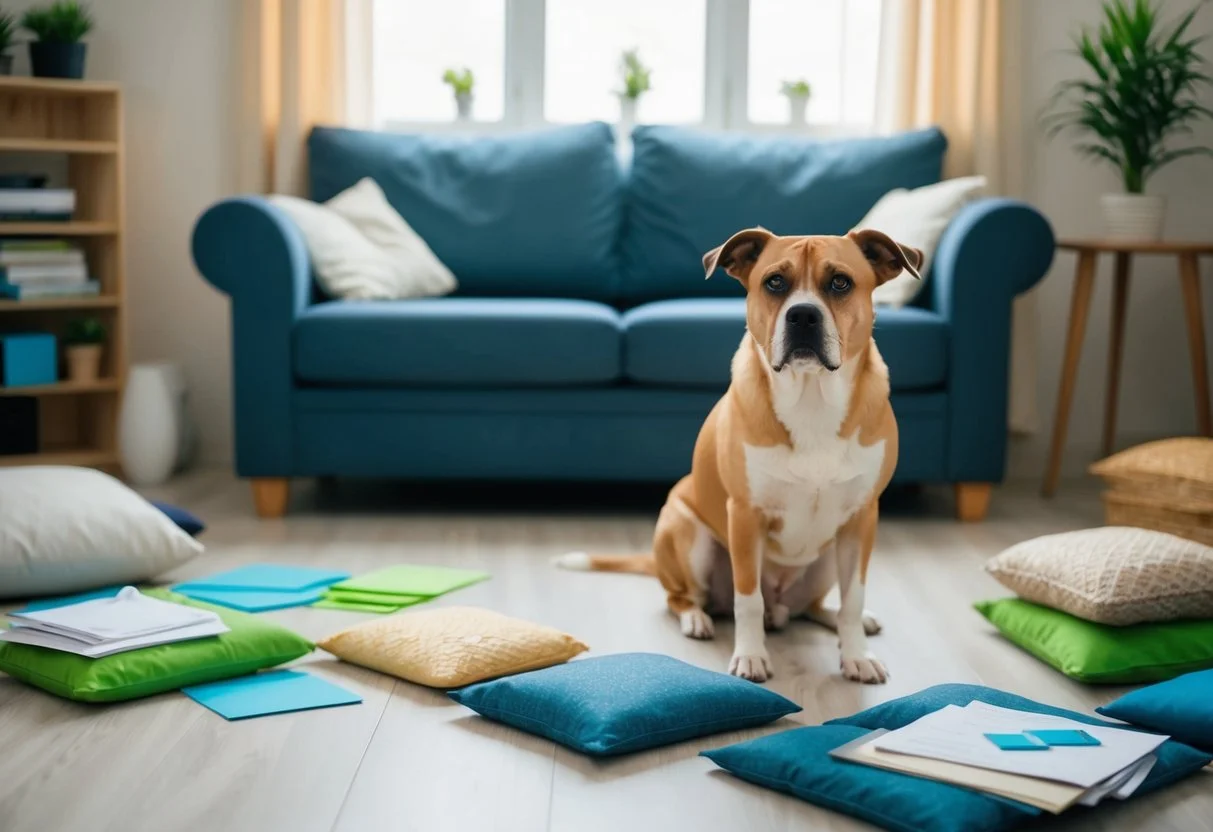
Taking steps early on can help your dog avoid developing separation anxiety in dogs. These approaches focus on building your dog’s confidence and creating positive associations with being alone.
Socialization and Early Training
Start socializing your puppy as early as possible. Expose them to different people, places, and situations. This builds their confidence and adaptability. Teach your dog to be comfortable alone for short periods. Begin with just a few minutes and gradually increase the time. Give them a special toy or treat when you leave.
Practice “fake departures,” where you go through your leaving routine but don’t leave. This helps your dog learn that your actions don’t always mean you’re going away. Encourage independence by not always being in the same room as your dog. Let them explore on their own sometimes. Crate training can be helpful. Make the crate a positive space with toys and treats.
Routine and Predictability
Establish a consistent daily routine for your dog. This includes regular meal times, walks, and playtime. Create a calm environment before you leave. Don’t make a big fuss about departures or arrivals. Keep your energy level low. Leave some background noise, like a radio or TV, when you’re gone. This can help mask outside noises that might trigger anxiety.
Make sure your dog gets enough exercise and mental stimulation. A tired dog is more likely to relax when alone. Consider using puzzle toys or slow feeders to keep your dog occupied while you’re away. These can provide mental stimulation and distraction.
Separation Anxiety In Dogs: When to Seek Vet Assistance
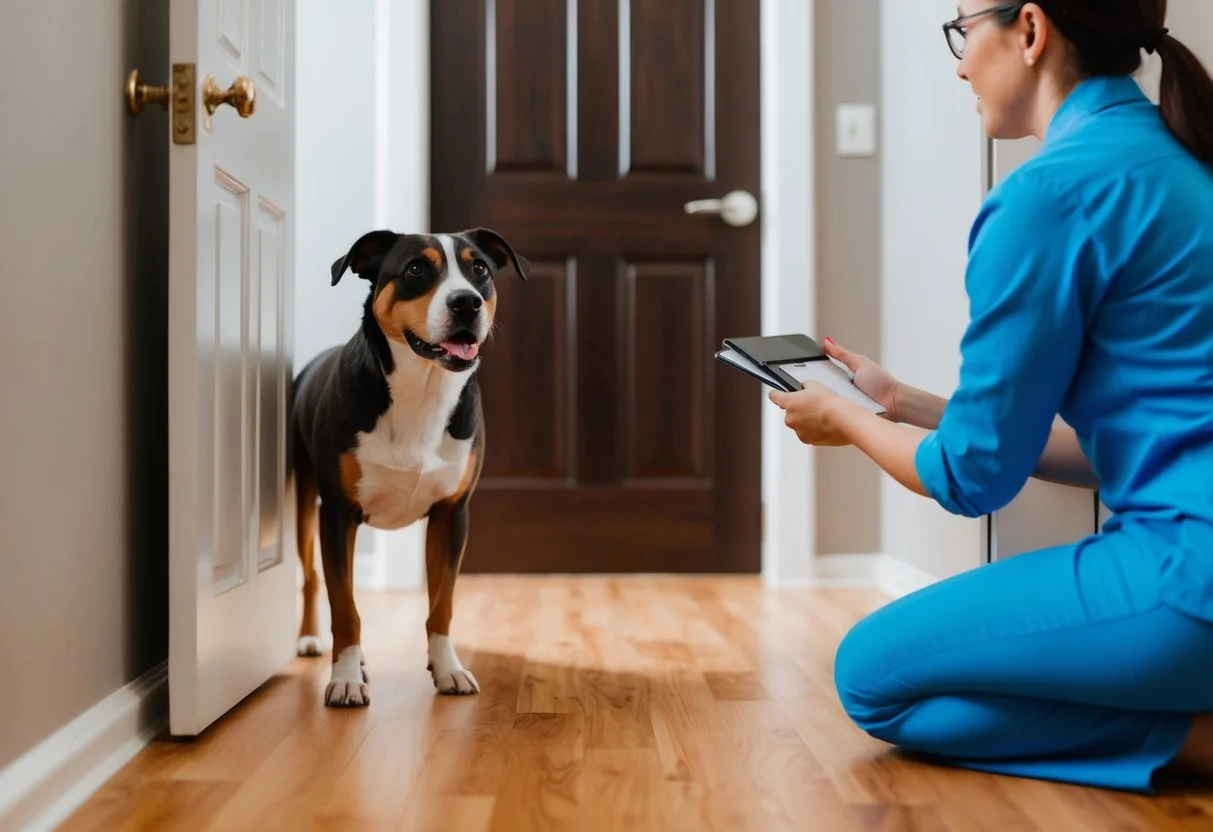
You should talk to your vet if your dog’s separation anxiety worsens with home training. Destructive behavior when left alone is a sign you need help. Call your vet if your dog hurts itself trying to escape. This can include scratching doors or breaking through windows. It’s time for a vet visit if your dog stops eating or drinking due to stress. Changes in appetite can be serious.
Seek help if your dog’s anxiety affects its daily life. This includes not being able to stay home alone at all. Your vet can rule out other health issues that might look like anxiety. They can also suggest medications if needed. Remember, it’s okay to ask for help. Your vet wants your dog to be happy and healthy. They can give you a plan to help your furry friend feel better.
Here’s an additional video about separation anxiety in dogs.
By: It’s Me or the Dog
Overcoming Separation Anxiety in Dogs
Addressing separation anxiety in dogs requires patience, consistency, and understanding. By identifying the root causes and implementing strategies like creating a safe space, training for independence, and providing mental stimulation, you can help your dog feel more secure when left alone. It’s essential to be proactive, whether seeking guidance from a vet or behaviorist, utilizing calming techniques, or introducing gradual departures. The goal is to reduce anxiety and foster a sense of comfort for your dog, leading to a calmer, happier household.
Ultimately, overcoming separation anxiety is a journey that involves time and dedication, but the results are well worth the effort. If needed, you can effectively manage and reduce your dog’s anxiety by combining training, behavioral modifications, and professional interventions. With a thoughtful approach, you can create a peaceful environment that allows your furry friend to thrive even when you’re not around.
Frequently Asked Questions
What Are the Common Symptoms of Separation Anxiety in Dogs?
Dogs with separation anxiety often show clear signs of distress. Whining, barking, or howling are common vocal cues. You might also notice pacing, trembling, or excessive panting when you’re about to leave. Some dogs may chew furniture, scratch at doors, or have accidents in the house. These behaviors usually happen when you’re gone or ready to go out.
Are There Effective Home Remedies to Help Dogs With Separation Anxiety?
You can try a few things at home to help your anxious pup. Leave a piece of clothing with your scent on it for comfort. Playing soft music or leaving the TV on can also help some dogs feel less alone. Try giving your dog a special toy or treat when you leave. This can create a positive link with your departure. Ensure your dog gets plenty of exercise before you go out, too.
How Can You Alleviate Separation Anxiety in Dogs When You Have to Leave Them Alone?
Start by making your departures low-key. Don’t make a big fuss when leaving or coming home. Gradually get your dog used to being alone by leaving for short periods and slowly increasing the time. You can also try leaving your dog in a safe, comfy space with toys and treats. Some dogs do well with puzzle toys that keep them busy while you’re gone.


